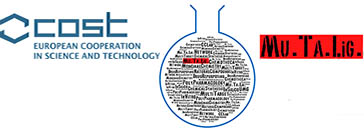
General information
| Name: Robert |
| Surname: Vianello |
| E-mail: robert.vianello@irb.hr |
| Cell phone number with international prefix: +385 91 2547100 |
| Country: Croatia |
| Affiliation: Ruđer Bošković Institute, Department of Organic Chemistry and Biochemistry, Zagreb, Croatia |
| Gender: M |
| Year of the PhD title: 2003 |
| Personal web page: http://www.irb.hr/eng/People/Robert-Vianello |
| Previous COST participation: Yes (COST CM1103, 2011–2015) |
List of 10 selected publications within last 5 years
| 1. R Vianello, J Mavri: “EVB simulation of the catalytic activity of monoamine oxidases: from chemical physics to neurodegeneration”, in Theory and applications of the empirical valence bond approach: from physical chemistry to chemical biology, SCL Kamerlin, F Duarte (Eds), John Wiley & Sons, 2016, in print. |
| 2. A Maršavelski, M Močibob, I Gruić-Sovulj, R Vianello: “The origin of specificity and insight into recognition between aminoacyl carrier protein and its protein partner”, Physical Chemistry Chemical Physics 2015, 17, 19030–19038. |
| 3. I Picek, R Vianello, P Šket, J Plavec, B Foretić: “Tandem β-elimination/hetero-Michael addition rearrangement of an N-alkylated pyridinium oxime to an O-alkylated pyridine oxime ether: an experimental and computational study”, Journal of Organic Chemistry 2015, 80, 2165–2173. |
| 4. I Despotović, R Vianello: “Engineering exceptionally strong oxygen superbases with 1,8-diazanaphthalene di-N-oxides”, Chemical Communications 2014, 50, 10941–10944. |
| 5. M Glušič, J Stare, J Grdadolnik, R Vianello: “Binding of cadmium dication to glutathione facilitates cysteine –SH deprotonation: a computational DFT study”, Journal of Inorganic Biochemistry 2013, 119, 90–94. |
| 6. R Vianello, M Repič, J Mavri: “How are biogenic amines metabolized by monoamine oxidases?”, European Journal of Organic Chemistry 2012, 7057–7065. |
| 7. R Borštnar, M Repič, SCL Kamerlin, R Vianello, J Mavri: “Computational study of the pKa values of potential catalytic residues in the active site of monoamine oxidase B”, Journal of Chemical Theory and Computation 2012, 8, 3864–3870. |
| 8. R Vianello, J Mavri: “Microsolvation of the histamine monocation in aqueous solution: the effect on structure, hydrogen bonding ability and vibrational spectrum”, New Journal of Chemistry 2012, 36, 954–962. |
| 9. R Borštnar, M Repič, M Kržan, J Mavri, R Vianello: “Irreversible inhibition of monoamine oxidase B by the antiparkinsonian medicines rasagiline and selegiline: a computational study”, European Journal of Organic Chemistry 2011, 6419–6433. |
| 10. J Stare, J Mavri, J Grdadolnik, J Zidar, ZB Maksić, R Vianello: “Hydrogen bond dynamics of histamine monocation in aqueous solution: Car–Parrinello molecular dynamics and vibrational spectroscopy study”, Journal of Physical Chemistry B 2011, 115, 5999–6010. |
Main skills and expertise (up to 5)
| 1. Multi-scale computational physical-organic chemistry, biochemistry and enzymology |
| 2. Modeling of the mechanism of the enzyme reactivity and the influence of point mutations |
| 3. Investigation of the modes of drug binding and the mechanism of inhibition |
| 4. Studying the interaction among biological molecules, small organic systems and metal cations |
| 5. Computational design of novel molecules as efficient and potent inhibitors |
Main equipment/facilities available in the participants’ lab (up to 5)
| 1. A LINUX cluster consisting of 12 HP blade servers with 240 CPU cores and 768 GB RAM memory, together with a broad access to large national and international computational facilities. |
| 2. A full-time access to the Croatian University Computing Centre (http://www.srce.hr) hosting national cluster (800 CPU cores, 4 GPU cores, 5 TB RAM memory, 200 TB disk space) and GRID infrastructures (1652 CPU cores, 32 GPU cores, 10 TB RAM memory, 200 TB disk space). |
| 3. A broad range of quantum-chemical software and program packages required for multi-scale computational simulations. |
| 4. |
| 5. |
Short personal activity proposal for the COST Action CA15135 (max 1000 characters)
|
I see my role in this COST Action in applying diverse computational approaches to model the various kinetic and thermodynamic aspects of the biological systems that are in the focus of the Action. This will help in revealing the precise molecular mechanism and the related free-energy profiles of the catalytic activity and inhibition of several enzymes, thus aid in interpreting multidisciplinary biochemical research proposed here and provide directions for the design of the efficient inhibitors as transition-state analogues. Computational simulations will be used to identify the key residues responsible for the inhibitor binding and complex/adduct stabilization, thus guiding in the selection of point mutations for experimental studies and the cell biology investigations. Having the input from the isotope labeling experiments, we shall apply advanced nuclear quantization simulations to model the kinetic isotope effects that would provide further support to the proposed mechanisms in both wild-type and mutant enzymes. After the initial set of theoretical results, the subsequent experimental data will further refine our models in an iterative manner. |
Work Group preference: score from 1 (preferred) to 4 (not preferred)
| Work Group of the CA15135 COST Action | Score |
| WG1: Development of new chemical entities | 2 |
| WG2: Selection of biological targets and assessment of biological data | 3 |
| WG3: Development of chemical databases | 4 |
| WG4: Development of Computational methods for multiple ligand design and discovery | 1 |
